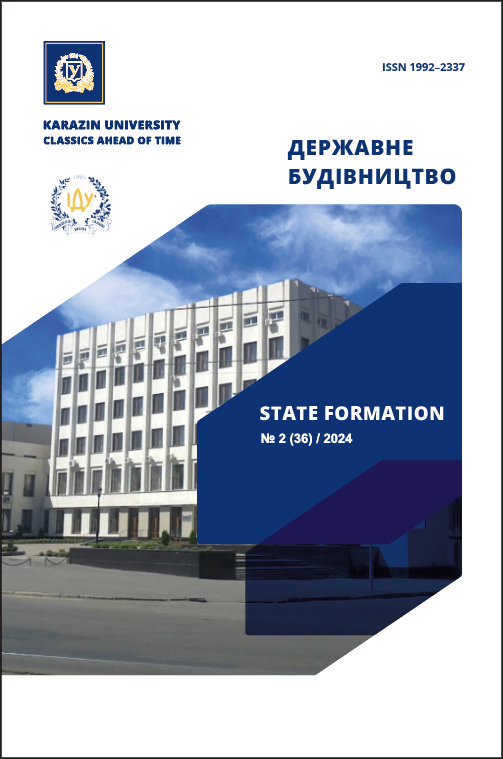Забезпечення створення безбар’єрного простору в Україні
Анотація
У статті на підставі логічного співвідношення окремих понять розкрито зміст поняття «безбарєрний простір», оскільки на сьогодні не існує науково прийнятого, чи затвердженого нормативними актами України визначення даного поняття. Доцільно вважати, що безбар’єрний простір – це безперешкодне життєве середовище, де забезпечені рівні можливості, права людей, їх рівноправний доступ до ресурсів та гарантії на отримання допомоги.
У статті доведено, що значна частина термінів, що передують розкриттю змісту поняття «безбарєрний простір», є такими, що потребують перш за все категоріального, а іноді і понятійного уточнення. Стверджується, що інклюзію, як найближче поняття щодо створення безбар’єрного простору, слід розуміти як процес забезпечення збільшення ступеня участі всіх громадян у соціумі. Інклюзивність при цьому категоріально необхідно розглядати як характеристику чогось: середовища, явища, політики, у яких враховані потреби різних людей. Ці поняття не є тотожними.
У статті визначено, що бар’єри, як перешкоди на шляху до повноцінної участі в житті суспільства, можна поділити за ознакою створення таких перешкод, а саме на індивідуальні, інфраструктурні, інституційні бар’єри та бар’єри толерантності. Подолання бар’єрів забезпечує доступність, яка категоріально є результатом процесу, а саме процесу забезпечення рівного доступу всім групам населення до різного роду об’єктів та послуг тощо. При цьому безбар’єрність необхідно вважати концепцією, яка направлена на створення умов, у яких всі люди, незалежно від їхніх особливостей, мають рівний доступ до різних аспектів суспільного життя. Виходячи саме з такого тлумачення безбар’єрності стають у відповідність і інші неузгоджені визначення, що містять нормативно-правові акти та різного роду публікації.
У статті зроблено висновок, що створення безбар’єрного простору є процесом забезпечення захисту і реалізації прав усіх громадян у різного роду сферах суспільного життя, і перелік цих сфер не може бути вичерпним, як і дії усіх учасників процесу.
Створення безбар’єрного простору передбачає забезпечення рівноцінного доступу людей з різними можливостями до усіх сфер суспільного життя, що є одним із завдань органів влади та інститутів громадянського суспільства.
Завантаження
Посилання
Vasylieva, G.I. & Lyubarets, V.V. (2018). Terminological dictionary-inclusion. Kyiv: Millennium. [in Ukrainian].
Volgina, O.M. & Ivanova, O.L. (2018). Social support of people with disabilities at the workplace: a guide. UNDP in Ukraine, Joint Program «Promotion of Integration Policy and Services for People with Disabilities in Ukraine». Kyiv: Vaite. [in Ukrainian].
Disability and society: educational and methodological manual / by general ed. Baidy L.Yu., Krasyukova-Enns O.V. (2012). Kyiv. [in Ukrainian].
Inclusion. Explanatory dictionary of the Ukrainian language. URL: https://slovnyk.ua/index.php?swrd=інклюзія [in Ukrainian].
Komar, O.A. & Pisnyak, V.S. (2021). Inclusion as an innovative way of educational development. Proceedings. Series: Pedagogical sciences. 24–29. DOI: https://doi.org/10.36550/
-7988-2021-1-194-24-29 [in Ukrainian].
UN Convention on the Rights of Persons with Disabilities. URL: https://zakon.rada.
gov.ua/laws/show/995_g71#Text [in Ukrainian].
Nalivaiko, L.R. & Martsenyuk, L.V. (2023). «Barrier-free Ukraine»: problems and prospects. New Ukrainian law, 4, 82–93. [in Ukrainian].
Nothing for us without us: a guide to inclusive decision-making for public authorities. (2015). Compilers: Azin V.O., Bayda L.Yu., Goss N., Zhdan P.M., Sukhinina I.M., Fletcher A. Kyiv: Lenvit. URL: https://www.britishcouncil.org.ua/sites/default/files/toolkit_pm_ukr.pdf [in Ukrainian].
Law of Ukraine оn making changes to some laws of Ukraine on education regarding the organization of inclusive education № 1324-VII. (2014, June 5). URL: https://zakon.rada.gov.ua/
laws/show/1324-18#Text [in Ukrainian].
Decree of the President of Ukraine оn ensuring the creation of a barrier-free space in Ukraine № 533/2020. (2020, December 3). URL: (2020). https://www.president.gov.ua/documents/
-35809 [in Ukrainian].
Resolution of the Cabinet of Ministers of Ukraine оn approving accessibility criteria for persons with disabilities and other low-mobility population groups of premises provided to precinct election commissions of regular polling stations for organizing their work and conducting voting № 962. (2020, October 9). (2020). URL: https://zakon.rada.gov.ua/laws/show/962-2020-%D0%BF#Text [in Ukrainian].
Decree of the Cabinet of Ministers of Ukraine оn the approval of the plan of measures to create a barrier-free living environment for persons with limited physical capabilities and other groups with limited mobility for 2009-2015 «Barrier-free Ukraine» № 784. (2009, July 29). (2009). URL: https://www.kmu.gov.ua/npas/232167617 [in Ukrainian].
Law of Ukraine оn rehabilitation of persons with disabilities in Ukraine № 2961-IV. (2005, October 6). (2005). URL: https://zakon.rada.gov.ua/laws/show/2961-15#n16 [in Ukrainian].
Order of the Cabinet of Ministers of Ukraine оn the approval of the National Strategy for the creation of a barrier-free space in Ukraine for the period up to 2030 № 366. (2021, April 14). (2021). URL: https://zakon.rada.gov.ua/laws/show/366-2021-%D1%80#Text [in Ukrainian].
Slobodian, L.Ya. (2024). The concept of «barrier-free» as an object of research. Problems of modern transformations. Series: law, public management and administration, 11. URL: https://doi.org/10.54929/2786-5746-2024-11-02-05 [in Ukrainian].
Council Directive 2000/78/EC of 27 November 2000 establishing a general framework for equal treatment in employment and occupation. (2000). URL: https://eur-lex.europa.eu/eli/dir/2000/78/oj
Future of Jobs Report (2023). INSIGHT REPORT. MAY 2023. URL:https://www3.weforum.org/docs/WEF_Future_of_Jobs_2023.pdf
International Classification of Functioning, Disability and Health, ICF. URL: https://www.who.int/standards/classifications/international-classification-of-functioning-disability-and-health
Nationaler Aktionsplan 2.0. URL: https://www.bmas.de/DE/Soziales/Teilhabe-und-Inklusion/Nationaler-Aktionsplan/nationaler-aktionsplan-2-0.html#:~:text=Juni%202016%20die
%20zweite%20
Sehrawat, S., George, A., Menon, B.G. (2023). Holistic Age-Friendly Communities: A Comprehensive Literature Review on Factors Affecting the Elderly Experience in Built Environments. In: Goswami, A.K., Aithal, B.H., Maitra, S., Banerjee, A. (eds) Infrastructure and Built Environment for Sustainable and Resilient Societies. IBSR 2023. Sustainable Civil Infrastructures. Springer, Singapore. DOI: https://doi.org/10.1007/978-981-97-1503-9_10

